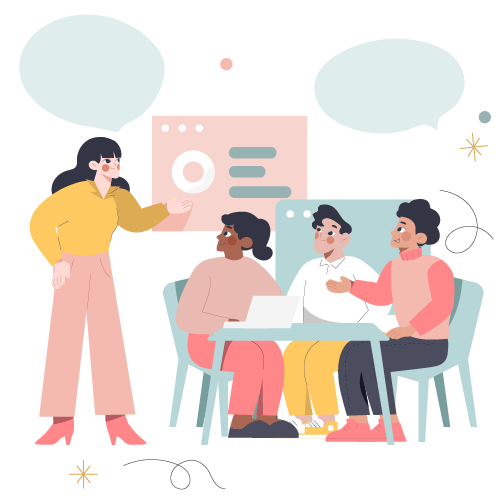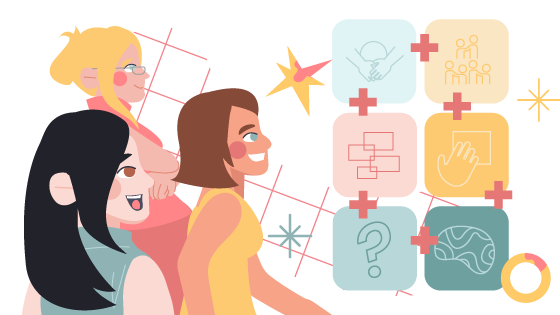“Corporate learning” is a phrase that brings mixed reactions among leaders and teams. Some view it as a great opportunity for growth, while others might be tied up in misconceptions about what it is and how it works. Corporate learning opportunities today aren’t the same as in the past, and it’s time to talk about why corporate learning should be embraced and the potential it holds for businesses.
Today, learning in the corporate environment goes beyond stuffy conference rooms and flat learning materials and has become an engaging, thought-provoking opportunity to bring out the true potential and natural talents in teams and leadership at every level.
What is corporate learning?
Corporate learning can take various forms, but they all have several key features in common. Corporate learning and development programs are structured opportunities for employees of all levels to refine their expertise, acquire new skills, and stay competitive in today’s current markets. This holds true regardless of the industry.
Every employee has something valuable to offer and, when done right, corporate learning helps both employees and leaders tap into this potential.
This isn’t about rushing through a learning program but, instead, knowing how to adapt learning to lift corporate team members, enhance their performance, generate innovation, and nurture a culture that supports and encourages continuous improvement.
A great corporate learning program boosts morale, improves workplace culture, and plants the seeds for true leaders to be born.
These learning programs and initiatives can take the shape of everything from on-the-job learning to high-impact leadership development training.
Additionally, the shift toward digital transformation means that corporate eLearning has become central in employee and leadership development programs. eLearning can help make these programs more accessible as well as data-driven and scalable in the long term.
What makes corporate learning work?
Learning and development professionals, along with HR leaders, know that corporate learning programs need to be strategic to be effective. There isn’t a one-size-fits-all option that works to motivate, inspire, engage, and uplift corporate teams.
At their core, successful corporate learning programs do more than provide information. They transform entire teams into strong performers. To accomplish this, high-level, effective programs are built on several key principles.
Strategic alignment
Not all businesses benefit from the same learning initiatives and programs. Corporate learning should always be strategically aligned and directly connected to business goals.
This might take the shape of upskilling current employees for future roles or enhancing leadership capabilities for businesses that are on strong growth trajectories.
It might also look like embracing multiple learning programs to differentiate skills and build employees from where they are by honing in on their strongest points and talents.
The best learning programs support long-term company growth and objectives.
Multi-modal delivery
The best corporate learning experiences are ones that are tailored to individual teams and their objectives. From interactive corporate e-learning modules to hands-on workshops and learning initiatives, today’s smart corporate leaders are learning to leverage the different available learning formats and programs to meet their teams according to their current learning paths and learning preferences.
Real-time adaptability
For modern businesses, successful learning strategies thrive on agility. Continually evaluating and refining learning programs is essential. This involves considering industry changes and how they affect current operations and employee expectations.
Successful corporate learning programs are also adaptable based on performance data and learner feedback, as well as other types of feedback that make the programs more effective and aligned with changing corporate goals.
Designed experience vs. Passive consumption
Paying attention to how teams consume content and learn is critical to the success of corporate learning and development programs. Going beyond passive content consumption and moving into creating structured experiences that truly engage is a major game-changer.
When learners become engaged, the level of knowledge retention skyrockets, along with interest in tuning in and getting the most from the experience. Designed experiences also help learners discover how to apply what they’re learning to real-world scenarios and how to adapt their approach in different circumstances.
Partnering with experts vs. Buying content libraries
There is a strong distinction between off-the-shelf content libraries and curated, expert-led programs. While it’s true that broad learning libraries offer a level of easy accessibility, they can miss the mark on many of the points we’ve already covered here.
As an example, content libraries lack adaptability and are often built on passive consumption, rather than tailored experiences. There’s also a good chance that content libraries aren’t 100% aligned with a business’s strategic goals.
However, curated content libraries can be the best option in certain scenarios. For example, if the learning goal is to zone in on leadership training, conflict resolution, or emotional intelligence training, an expertly designed content library can offer a specialized focus. Additionally, off-the-shelf eLearning courses can be a cost-effective solution for growing businesses.
On the flip side, we have corporate learning experts. Partnering with a trusted corporate learning specialist ensures your learning solutions are tailored to the needs of the learners, corporate goals, and with real-time insight into how the industry is changing.
Types of corporate learning programs
Today’s businesses are dynamic and constantly adapting to shifting industry demands, trends, and expectations. It’s important to explore a range of corporate learning programs to meet the needs of learners in the modern corporate environment.
There are several options to explore. Here’s a look at the most common types of corporate learning programs today.
Corporate eLearning
Corporate eLearning has changed the educational landscape for corporate learners. Digital learning solutions allow employees to access their learning materials anytime, anywhere. Corporate e-learning supports the education and leveling-up of learners while also respecting their valuable role in the company and their time.
eLearning platforms are built on interactive modules and adaptable personalization to scale training effectively, while maintaining both operational and learning consistency across the board.
Instructor-led learning
Traditional or hybrid learning sessions that are led by corporate learning experts are unique in the way they foster direct engagement as well as real-time feedback.
As valuable as eLearning is in the corporate environment, expert instructor-led learning offers a level of engagement that can energize and excite learners in a way that other modes of learning can’t quite tap into.
Instructor-led learning is especially valuable for targeted learning areas, such as leadership development, compliance training, and specific skill building that benefits from mentorship and hands-on practice.
Targeted learning strategy
Highly customized training is appropriate when considering corporate learning options for specific roles, complex industries, and organizational objectives. Targeted learning is built on a foundation of microlearning objectives that build upon each other and are adaptive to personalize development along the way.
Targeted learning strategies allow learners to receive the most relevant and impactful education and are ideal for learners who are headed toward growth, both in their current position as well as in future opportunities.
Why is corporate learning a strategic advantage?
Businesses that invest in corporate learning and development are fueling their organization’s long-term success. In fact, investing in learning opportunities for their workforce is one of the most strategic moves that businesses can make today.
When considering corporate learning advantages and disadvantages, here are the main benefits it offers.
- Enhanced productivity: Learners who have received expert, structured, and adaptable training are more likely to perform at their highest level of efficiency and productivity. It’s the simple act of providing learners with the knowledge, skills, and insights to perform their role at their highest level that lifts team members and helps them succeed.
- Bridging the skills gap: Skills gaps can impede efficiency and performance, especially in teams that are experiencing rapid growth. Team members at all levels can experience a gap in skills at any point when major shifts in objectives and growth are experienced on a broad scale. Corporate learning helps to fill in those gaps and ensure cohesiveness during times of change and transition.
- Improved employee engagement: An engaged team is one in which leaders are born and thrive. Engaging, interactive, and thought-provoking learning can get teams fired up, view competition as an exciting challenge, and get them invested in the future.
- Stronger leadership pipelines: Smart corporations know that tomorrow’s leaders are waiting in the wings. Training future leaders today helps businesses plan for the future by securing leadership succession and organizational stability.
- Consistency among in-person and remote employees: One of the biggest challenges businesses have faced with the surge of remote work culture is a lack of cohesiveness between remote and in-person teams. A strong corporate learning program bridges the gap and creates a cohesive, consistent knowledge base and skill set among all workers.
- Increased business agility: Teams that are provided with on-the-job learning opportunities have the skills to adapt more quickly to challenges like sudden changes to market trends or the adoption of new technological advancements. New learning opportunities improve mental agility, which then converts to adaptability and agility on the business end.
Who owns corporate learning?
A common question that pops up is who actually owns corporate learning. The answer is that it varies across organizations, often depending on size, objectives, and growth trajectory of the business. In general, corporate learning typically falls under these three functions:
- HR: Learning objectives here focus on workforce development and supporting the overall employee experience.
- L&D: Leadership development is key in designing, implementing, and measuring the success of learning initiatives.
- Business Units: This is where role-specific training needs are born. These specialized departments can ensure that learning objects are aligned with the company’s operational goals.
Building a culture of learning starts with intentional design
At ELM, we know that building a thriving corporate culture isn’t something that happens by chance or pure luck. It’s the product of deliberate strategy and an investment in the employees that makes companies great.
Organizations that prioritize learning in their business model are nourishing an environment where learners are continually improving and fueling innovation—and we’re the experts who are here to help.
Corporate learning is the path forward, offering a strategic advantage and future-proofing organizations and their workforce.
Discover for yourself how ELM learning can help you tap into the potential of effective corporate training services that are designed for your success.





